Multi-Temporal Analysis of the Impact of Summer Forest Dynamics on Urban Heat Island Effect in Yan’an City
Abstract
:1. Introduction
2. Materials and Methods
2.1. Study Area
2.2. Methodological Framework
2.3. Data Sources
2.3.1. MODIS Land Products
2.3.2. China Land Cover Dataset (CLCD)
2.3.3. Statistical Data
2.4. Processing Methods
2.4.1. Calculate NDVI
2.4.2. Extraction of UHI Areas and UHI Intensity Calculation
- (1)
- Calculation of LST
- (2)
- Extraction of UHI Region
- (3)
- Calculation of surface UHI intensity (SUHII)
2.4.3. Statistical Analysis
- (1)
- Correlation Analysis
- (2)
- Overlay Analysis
3. Results
3.1. Interannual Variation of NDVI and Vegetation Coverage in Yan’an City
3.2. Interannual Variation of Temperature Field and UHI in Yan’an City
3.3. Impact of Forests on the UHI in Yan’an City
4. Discussion
- Green roofs, green facades, etc.
- 2.
- Altering the surface materials of the building
- 3.
- Rationalize the urban pattern
5. Conclusions
Author Contributions
Funding
Institutional Review Board Statement
Informed Consent Statement
Data Availability Statement
Acknowledgments
Conflicts of Interest
Abbreviations
| CLCD | China Land Cover Dataset |
| NDVI | normalized difference vegetation index |
| LST | land surface temperature |
| UHI | urban heat island |
| UHII | urban heat island intensity |
| MODIS | moderate resolution imaging spectroradiometer |
| GEE | Google Earth Engine |
References
- Oke, T.R. The energetic basis of the urban heat island. Q. J. R. Meteorol. Soc. 1982, 108, 1–24. [Google Scholar] [CrossRef]
- Benjamin, K.; Luo, Z.; Wang, X. Crowdsourcing Urban Air Temperature Data for Estimating Urban Heat Island and Building Heating/Cooling Load in London. Energies 2021, 14, 5208. [Google Scholar] [CrossRef]
- Yoro, K.O.; Daramola, M.O. CO2 emission sources, greenhouse gases, and the global warming effect. Adv. Carbon Capture 2020, 3, 28. [Google Scholar]
- Tam, B.Y.; Gough, W.A.; Mohsin, T. The impact of urbanization and the urban heat island effect on day to day temperature variation. Urban Clim. 2015, 12, 1–10. [Google Scholar] [CrossRef]
- Cheng, Z.; Yang, X.; Sun, C.; Xu, Y. Summer Urban Heat Island Variation in Chengdu and Its Relationship with Urban Developmen (in Chinese). Clim. Chang. Res. 2016, 12, 322–331. [Google Scholar]
- Tan, J.; Zheng, Y.; Song, G.; Kalkstein, L.S.; Kalkstein, A.J.; Tang, X. Heat wave impacts on mortality in Shanghai, 1998 and 2003. Int. J. Biometeorol. 2007, 51, 193–200. [Google Scholar] [CrossRef] [PubMed]
- Buchin, O.; Hoelscher, M.-T.; Meier, F.; Nehls, T.; Ziegler, F. Evaluation of the health-risk reduction potential of countermeasures to urban heat islands. Energy Build. 2016, 114, 27–37. [Google Scholar] [CrossRef]
- Tsoka, S.; Tsikaloudaki, K.; Theodosiou, T.; Bikas, D. Urban Warming and Cities’ Microclimates: Investigation Methods and Mitigation Strategies—A Review. Energies 2020, 13, 1414. [Google Scholar] [CrossRef]
- Manoli, G.; Fatichi, S.; Schläpfer, M.; Yu, K.; Crowther, T.W.; Meili, N.; Burlando, P.; Katul, G.G.; Bou-Zeid, E. Magnitude of urban heat islands largely explained by climate and population. Nature 2019, 573, 55–60. [Google Scholar] [CrossRef]
- Al-Saadi, L.M.; Jaber, S.H.; Al-Jiboori, M.H. Variation of urban vegetation cover and its impact on minimum and maximum heat islands. Urban Clim. 2020, 34, 100707–100717. [Google Scholar] [CrossRef]
- Oke, T.R. Street Design and Urban Canopy Layer Climate. Energy Build. 1988, 11, 103–113. [Google Scholar] [CrossRef]
- Oh, Y. All London Green Grid as Nature-Based Solutions for Urban Resilience. In The Palgrave Handbook of Climate Resilient Societies; Springer International Publishing: Cham, Switzerland, 2020; pp. 1–23. [Google Scholar]
- Wong, N.H.; Tan, C.L.; Kolokotsa, D.D.; Takebayashi, H. Greenery as a mitigation and adaptation strategy to urban heat. Nat. Rev. Earth Environ. 2021, 2, 166–181. [Google Scholar] [CrossRef]
- Akbari, H.; Pomerantz, M.; Taha, H. Cool surfaces and shade trees to reduce energy use and improve air quality in urban areas. Sol. Energy 2001, 70, 295–310. [Google Scholar] [CrossRef]
- Malys, L.; Musy, M.; Inard, C. Direct and Indirect Impacts of Vegetation on Building Comfort: A Comparative Study of Lawns, Green Walls and Green Roofs. Energies 2016, 9, 32–52. [Google Scholar] [CrossRef]
- Lai, D.; Liu, W.; Gan, T.; Liu, K.; Chen, Q. A review of mitigating strategies to improve the thermal environment and thermal comfort in urban outdoor spaces. Sci. Total Environ. 2019, 661, 337–353. [Google Scholar] [CrossRef] [PubMed]
- Yujie, R.; Tang, X.; Fan, T.; Kang, D. Does the spatial pattern of urban blue–green space at city-level affects its cooling efficiency? Evidence from Yangtze River Economic Belt, China. Landsc. Ecol. Eng. 2023, 19, 363–379. [Google Scholar] [CrossRef]
- Amani-Beni, M.; Zhang, B.; Xie, G.-D.; Shi, Y. Impacts of Urban Green Landscape Patterns on Land Surface Temperature: Evidence from the Adjacent Area of Olympic Forest Park of Beijing, China. Sustainability 2019, 11, 513–529. [Google Scholar] [CrossRef]
- Cheng, X.; Wei, B.; Chen, G.; Li, J.; Song, C. Influence of Park Size and Its Surrounding Urban Landscape Patterns on the Park Cooling Effect. J. Urban Plan. Dev. 2015, 141, A4014002. [Google Scholar] [CrossRef]
- Chen, H.; Gu, L.; Lai, Y.Q.; Mu, C.L. Relationship between urban forest pattern and UHI effect in Chengdu city (in Chinese). Acta Ecol. Sin. 2009, 28, 4865–4874. [Google Scholar]
- Li, P.; Siddique, M.A.; Fan, B.; Huang, H.; Liu, D. Impact of Changes in Underlying Surface Cover Types on Urban Heat Islands: A Case Study of Chaoyang District, Beijing. J. Beijing For. Univ. 2020, 42, 99–109. (In Chinese) [Google Scholar]
- Peng, B.; Shi, Y.; Wang, H.; Wang, Y. The impacting mechanism and laws of function of urban heat islands effect: A case study of Shanghai. Acta Geogr. Sin. 2013, 68, 1461–1471. (In Chinese) [Google Scholar]
- Maharjan, M.; Aryal, A.; Man Shakya, B.; Talchabhadel, R.; Thapa, B.R.; Kumar, S. Evaluation of Urban Heat Island (UHI) Using Satellite Images in Densely Populated Cities of South Asia. Earth 2021, 2, 86–110. [Google Scholar] [CrossRef]
- Hsu, A.; Sheriff, G.; Chakraborty, T.; Manya, D. Disproportionate exposure to urban heat island intensity across major US cities. Nat. Commun. 2021, 12, 2721. [Google Scholar] [CrossRef] [PubMed]
- Zhang, K.; Lv, Y.; Fu, B. Vegetation restoration in typical areas of the Loess Plateau and its impact on ecosystem services (in Chinese). J. Ecol. Rural. Environ. 2017, 33, 23–31. [Google Scholar]
- Sun, Y.J.; Ren, Z.Y.; Hao, M.Y.; Duan, Y.F. Spatial and temporal changes in the synergy and trade-off between ecosystem services, and its influencing factors in Yanan, Loess Plateau (in Chinese). Acta Ecol. Sin. 2019, 39, 3443–3454. [Google Scholar]
- Das, P.; Vamsi, K.S.; Zhenke, Z. Decadal variation of the land surface temperatures (LST) and urban heat island (UHI) over Kolkata City projected using MODIS and ERA-interim DataSets. Aerosol Sci. Eng. 2020, 4, 200–209. [Google Scholar] [CrossRef]
- Monteiro, F.F.; Gonçalves, W.A.; Andrade, L.d.M.B.; Villavicencio, L.M.M.; dos Santos Silva, C.M. Assessment of Urban Heat Islands in Brazil based on MODIS remote sensing data. Urban Clim. 2021, 35, 100726. [Google Scholar] [CrossRef]
- Si, M.; Li, Z.-L.; Nerry, F.; Tang, B.-H.; Leng, P.; Wu, H.; Zhang, X.; Shang, G. Spatiotemporal pattern and long-term trend of global surface urban heat islands characterized by dynamic urban-extent method and MODIS data. ISPRS J. Photogramm. Remote Sens. 2022, 183, 321–335. [Google Scholar] [CrossRef]
- Pede, T.; Mountrakis, G. An empirical comparison of interpolation methods for MODIS 8-day land surface temperature composites across the conterminous Unites States. ISPRS J. Photogramm. Remote Sens. 2018, 142, 137–150. [Google Scholar] [CrossRef]
- Liu, J.; Hagan, D.F.T.; Liu, Y. Global Land Surface Temperature Change (2003–2017) and Its Relationship with Climate Drivers: AIRS, MODIS, and ERA5-Land Based Analysis. Remote Sens. 2020, 13, 44–64. [Google Scholar] [CrossRef]
- Qiao, Z.; Wu, C.; Zhao, D.; Xu, X.; Yang, J.; Feng, L.; Sun, Z.; Liu, L. Determining the Boundary and Probability of Surface Urban Heat Island Footprint Based on a Logistic Model. Remote Sens. 2019, 11, 1368–1388. [Google Scholar] [CrossRef]
- Yang, J.; Huang, X. The 30 m Annual Land Cover Datasets and Its Dynamics in China from 1985 to 2022 [Data Set]. 2023. Available online: https://zenodo.org/records/8176941 (accessed on 17 March 2024).
- Sharma, M.; Bangotra, P.; Gautam, A.S.; Gautam, S. Sensitivity of normalized difference vegetation index (NDVI) to land surface temperature, soil moisture and precipitation over district Gautam Buddh Nagar, UP, India. Stoch. Environ. Res. Risk Assess. 2021, 36, 1779–1789. [Google Scholar] [CrossRef] [PubMed]
- Chen, S.; Wang, T. Comparative Study on Defining Urban Heat Islands using Equidistant Method and Mean Standard Deviation Method. J. Geo-Inf. Sci. 2009, 11, 145–150. (In Chinese) [Google Scholar]
- Almeida, C.R.d.; Teodoro, A.C.; Gonçalves, A. Study of the Urban Heat Island (UHI) Using Remote Sensing Data/Techniques: A Systematic Review. Environments 2021, 8, 105–144. [Google Scholar] [CrossRef]
- Macarof, P.; Statescu, F. Comparasion of NDBI and NDVI as Indicators of Surface Urban Heat Island Effect in Landsat 8 Imagery: A Case Study of Iasi. Present Environ. Sustain. Dev. 2017, 11, 141–150. [Google Scholar] [CrossRef]
- Zhou, L.; Zhang, K. Spatiotemporal Changes in Vegetation Coverage and Influencing Factors in Yan’an City from 2000 to 2020. Bull. Soil Water Conserv. 2023, 43, 356–365. (In Chinese) [Google Scholar] [CrossRef]
- Du, G.; Sun, X.; Liu, Y.; Zheng, H.; Ma, R. Spatiotemporal Differentiation Characteristics of Ecological Retirement from Cultivated Land on the Loess Plateau. J. Geo-Inf. Sci. 2017, 19, 355–364. (In Chinese) [Google Scholar]
- Yang, L.; Meng, T. Spatiotemporal Dynamics of Vegetation in Yan’an City over the Past 20 Years Based on MODIS Data. West. Dev. (Res. Land Dev. Eng.) 2020, 5, 64–70. (In Chinese) [Google Scholar]
- Nie, T.; Dong, G.; Jiang, X.; Gu, J. Spatiotemporal Variation and Driving Forces of Vegetation Coverage in Yan’an Region. Res. Soil Water Conserv. 2021, 28, 340–346. (In Chinese) [Google Scholar] [CrossRef]
- Wang, X.; Yang, J.; Lin, L.; Wei, X. Study on the Spatiotemporal Variation of Vegetation Coverage in Shaanxi Province Based on Sen+Mann-Kendall. Agric. Technol. 2023, 43, 62–66. (In Chinese) [Google Scholar] [CrossRef]
- Xie, N. Dual Response of Vegetation Cover Change to Climate Change and Human Activities in Shaanxi Province (in Chinese). Master Thesis, Chang’an University, Xi’an, China, 8 April 2021. [Google Scholar]
- Xie, S.; Mo, X.; Hu, S.; Chen, X. Response of Vegetation Greenness to Temperature and Precipitation in the Three-North Shelter Forest Engineering Area. Geogr. Res. 2020, 39, 152–165. (In Chinese) [Google Scholar]
- Wang, H.; Liu, G.-h.; Li, Z.-s.; Ye, X.; Wang, M.; Gong, L. Driving force and changing trends of vegetation phenology in the Loess Plateau of China from 2000 to 2010. J. Mt. Sci. 2016, 13, 844–856. [Google Scholar] [CrossRef]
- He, L.; Jia, Z.; Wang, Z. Land-use/cover spatial-temporal change characteristic in Yan’an region. J. Nanjing For. Univ. (Nat. Sci. Ed.) 2015, 58, 173–176. [Google Scholar]
- Zhou, L.; Wang, P.; Cao, R. Analysis of soil erosion drivers and evaluation of ecological safety in Yan’an City, 2000–2020 (in Chinese). J. Ecol. Rural Environ. 2022, 38, 511–520. [Google Scholar]
- Wang, Z.; Wu, J.; Bai, S.; Shi, F.; Yao, Z. Spatial and temporal changes of sloping croplandresources and its soil erosion effects in Yan’an City, China (in Chinese). Res. Soil Water Conserv. 2022, 29, 1–11. [Google Scholar]
- Han, Z. Sensitivity evaluation of soil erosion in Yan’an citybased on USLE (in Chinese). Agric. Technol. 2020, 40, 120–124. [Google Scholar]
- Zaitunah, A.; Samsuri, S.; Silitonga, A.F.; Syaufina, L. Urban Greening Effect on Land Surface Temperature. Sensors 2022, 22, 4168. [Google Scholar] [CrossRef] [PubMed]
- Zhao, H.; Tan, J.; Ren, Z.; Wang, Z. Spatiotemporal Characteristics of Urban Surface Temperature and Its Relationship with Landscape Metrics and Vegetation Cover in Rapid Urbanization Region. Complexity 2020, 2020, 7892362. [Google Scholar] [CrossRef]
- Sun, Y.; Gao, C.; Li, J.; Li, W.; Ma, R. Examining urban thermal environment dynamics and relations to biophysical composition and configuration and socio-economic factors: A case study of the Shanghai metropolitan region. Sustain. Cities Soc. 2018, 40, 284–295. [Google Scholar] [CrossRef]
- Manso, M.; Teotónio, I.; Silva, C.M.; Cruz, C.O. Green roof and green wall benefits and costs: A review of the quantitative evidence. Renew. Sustain. Energy Rev. 2021, 13, 110111. [Google Scholar] [CrossRef]
- Cascone, S. Green Roof Design: State of the Art on Technology and Materials. Sustainability 2019, 11, 3020–3047. [Google Scholar] [CrossRef]
- Santamouris, M.; Yun, G.Y. Recent development and research priorities on cool and super cool materials to mitigate urban heat island. Renew. Energy 2020, 161, 792–807. [Google Scholar] [CrossRef]
- Feng, J.; Gao, K.; Santamouris, M.; Shah, K.W.; Ranzi, G. Dynamic impact of climate on the performance of daytime radiative cooling materials. Sol. Energy Mater. Sol. Cells 2020, 208, 110426. [Google Scholar] [CrossRef]
- Estoque, R.C.; Murayama, Y.; Myint, S.W. Effects of landscape composition and pattern on land surface temperature: An urban heat island study in the megacities of Southeast Asia. Sci. Total Environ. 2017, 577, 349–359. [Google Scholar] [CrossRef] [PubMed]
- Santos Nouri, A.; Costa, J.; Santamouris, M.; Matzarakis, A. Approaches to Outdoor Thermal Comfort Thresholds through Public Space Design: A Review. Atmosphere 2018, 9, 108. [Google Scholar] [CrossRef]
- Miao, C.; Yu, S.; Hu, Y.; Zhang, H.; He, X.; Chen, W. Review of methods used to estimate the sky view factor in urban street canyons. Build. Environ. 2020, 168, 106497. [Google Scholar] [CrossRef]
- Yang, G.; Yu, Z.; Jørgensen, G.; Vejre, H. How can urban blue-green space be planned for climate adaption in high-latitude cities? A seasonal perspective. Sustain. Cities Soc. 2020, 53, 101932. [Google Scholar] [CrossRef]
- Lin, J.; Qiu, S.; Tan, X.; Zhuang, Y. Measuring the relationship between morphological spatial pattern of green space and urban heat island using machine learning methods. Build. Environ. 2023, 228, 109910. [Google Scholar] [CrossRef]
- Liu, W.; Zhao, H.; Sun, S.; Xu, X.; Huang, T.; Zhu, J. Green Space Cooling Effect and Contribution to Mitigate Heat Island Effect of Surrounding Communities in Beijing Metropolitan Area. Front. Public Health 2022, 10, 870403. [Google Scholar] [CrossRef]

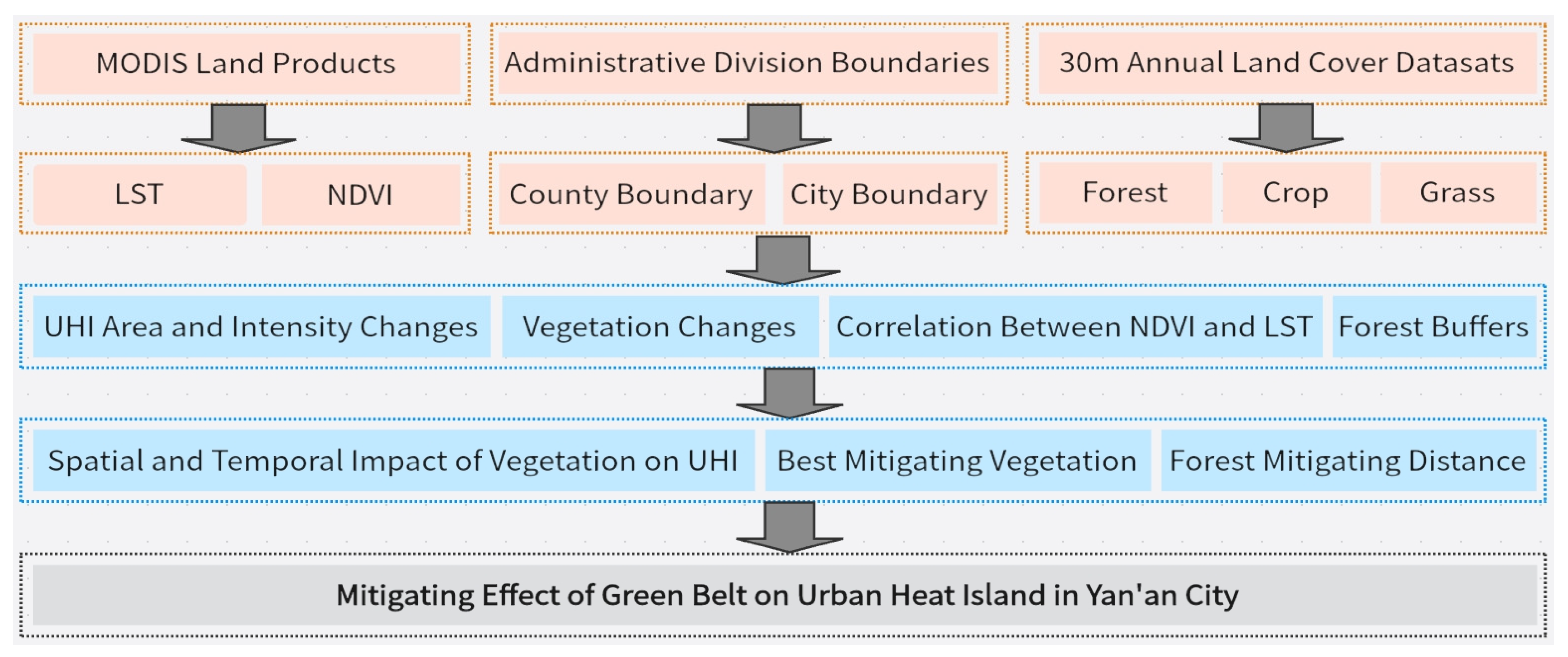
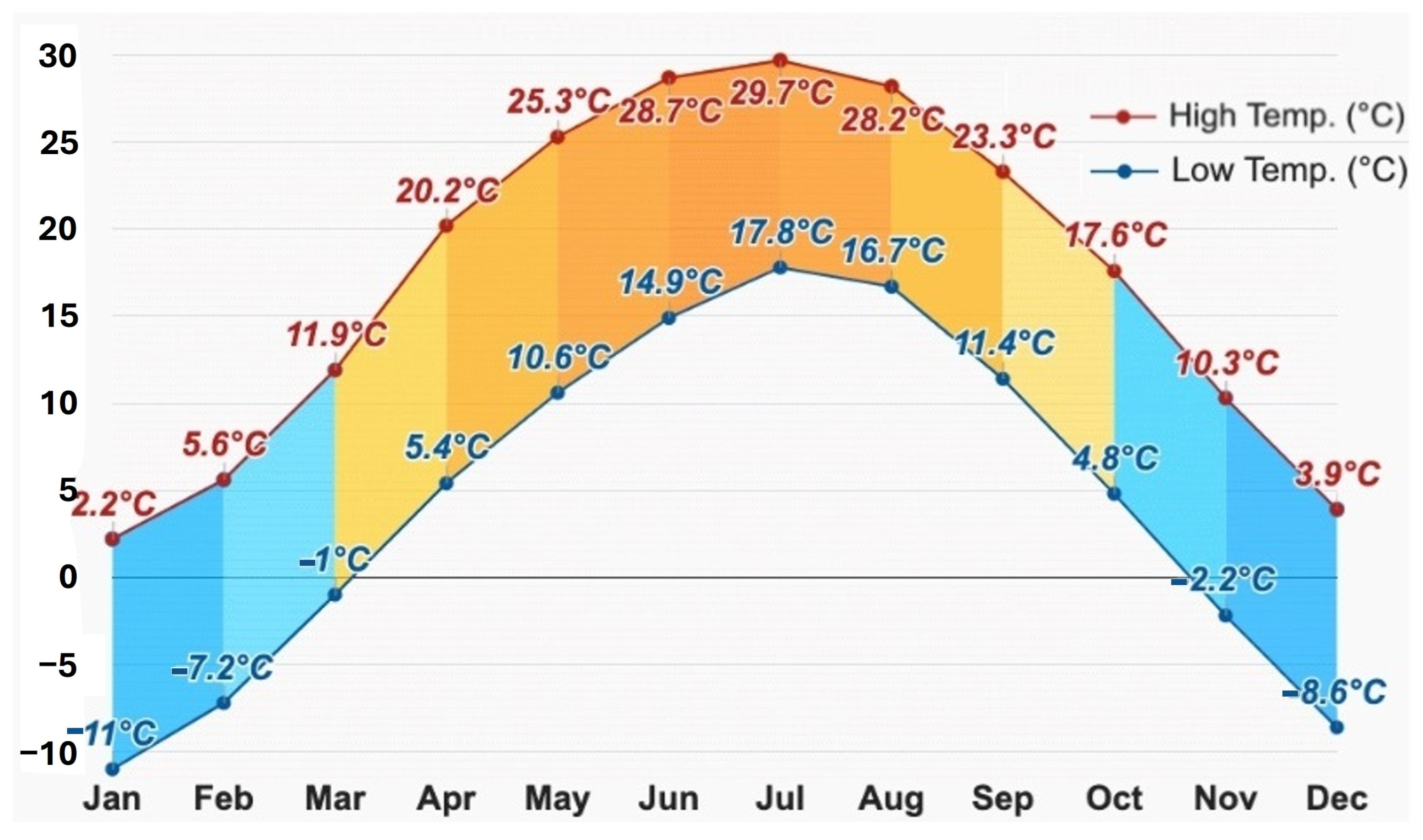
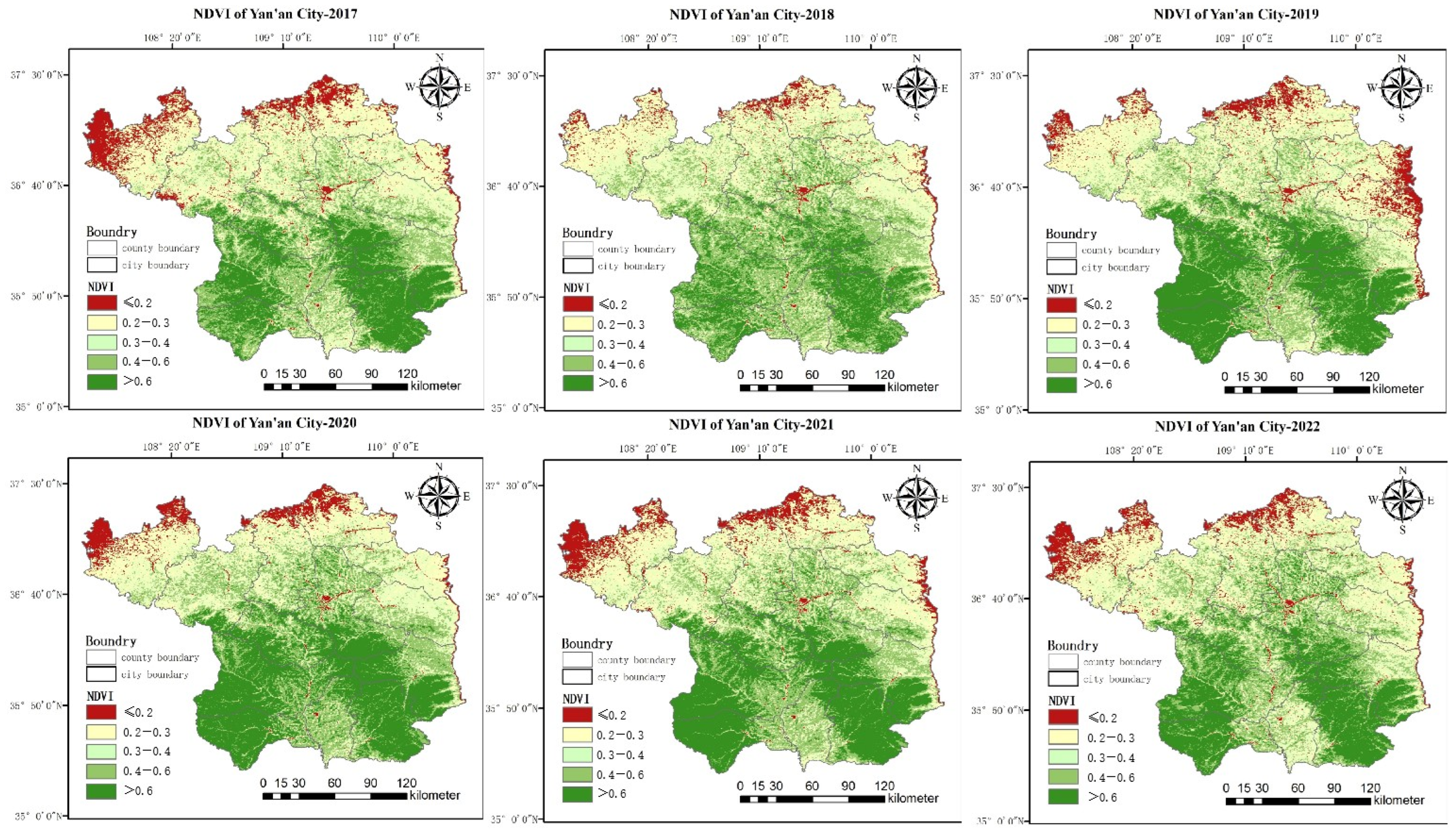
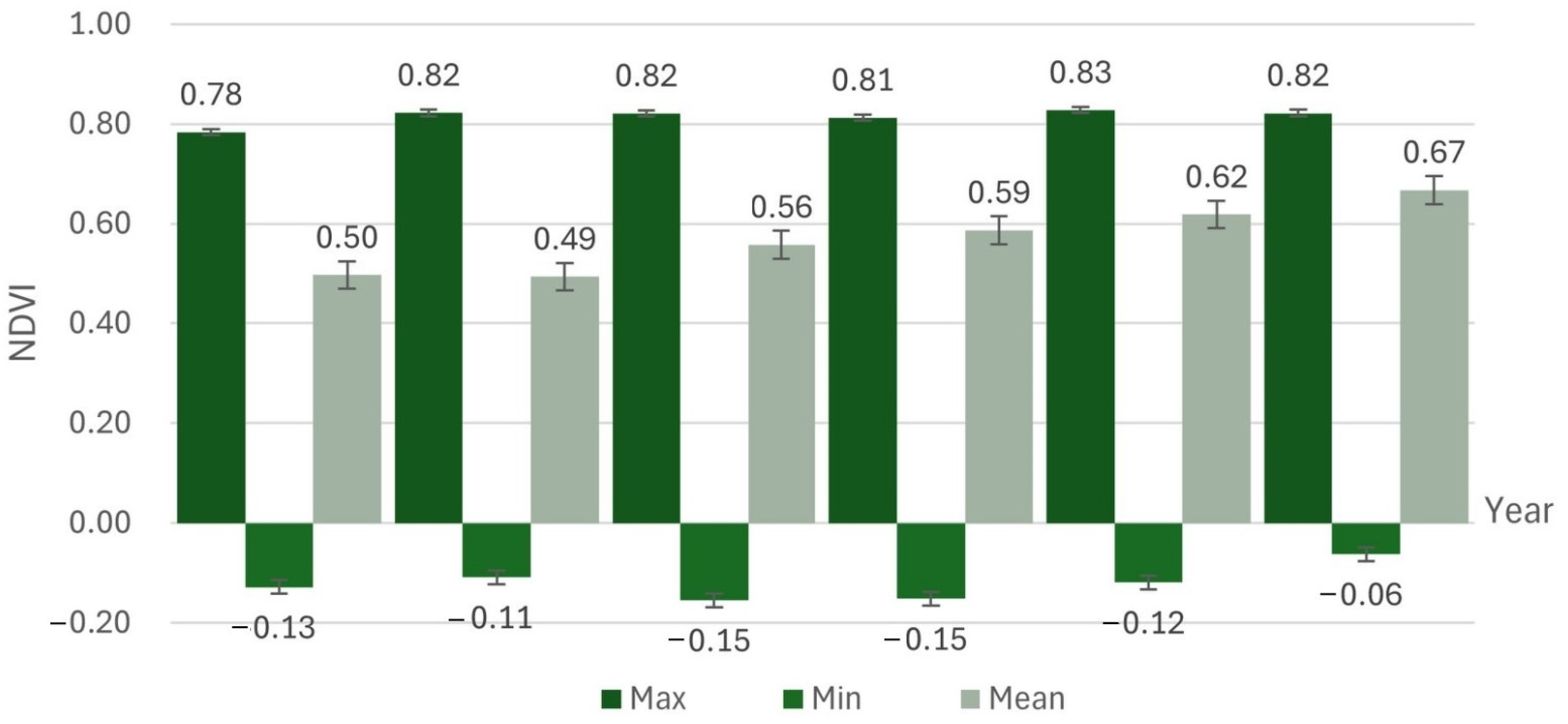
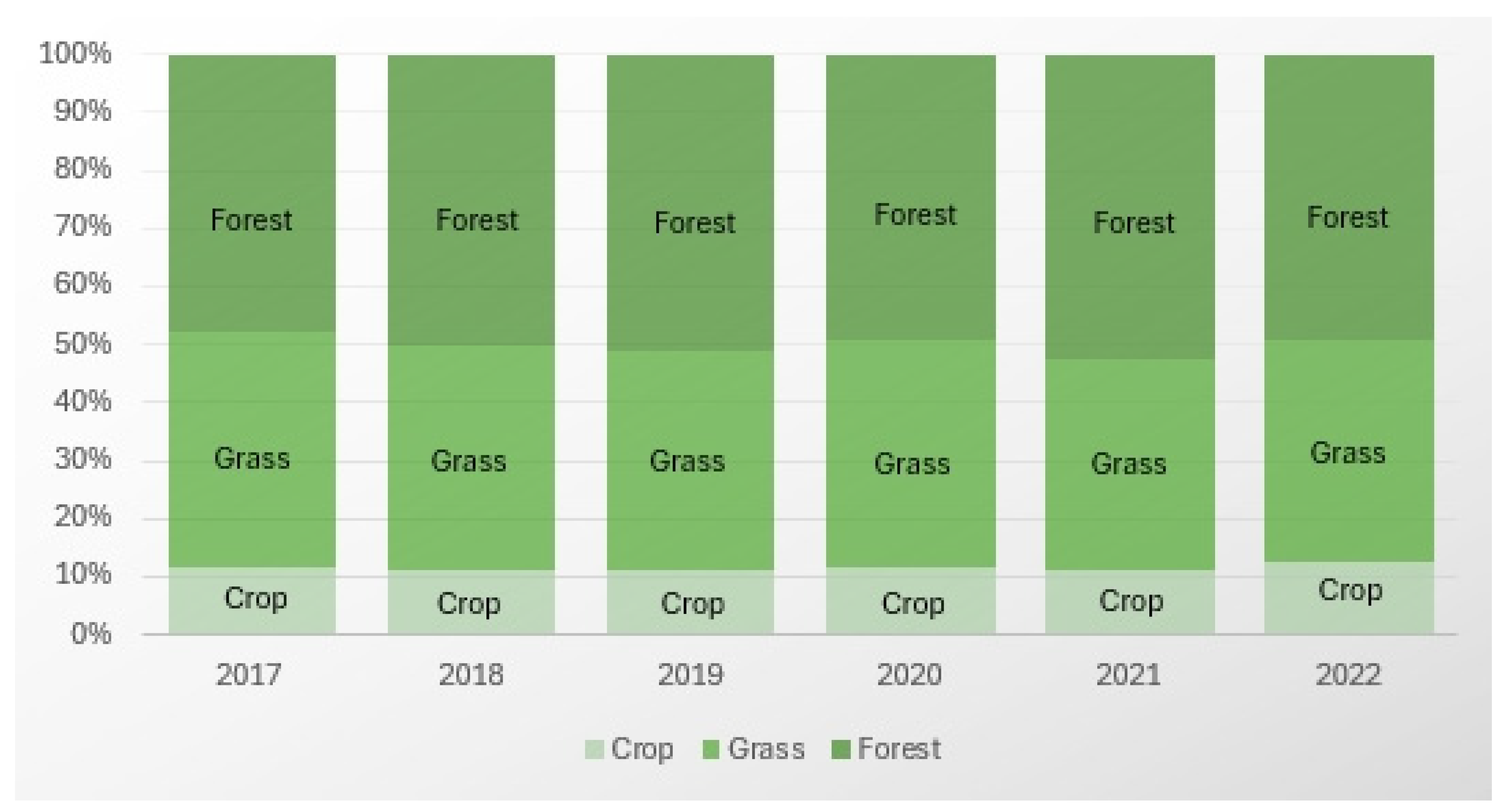
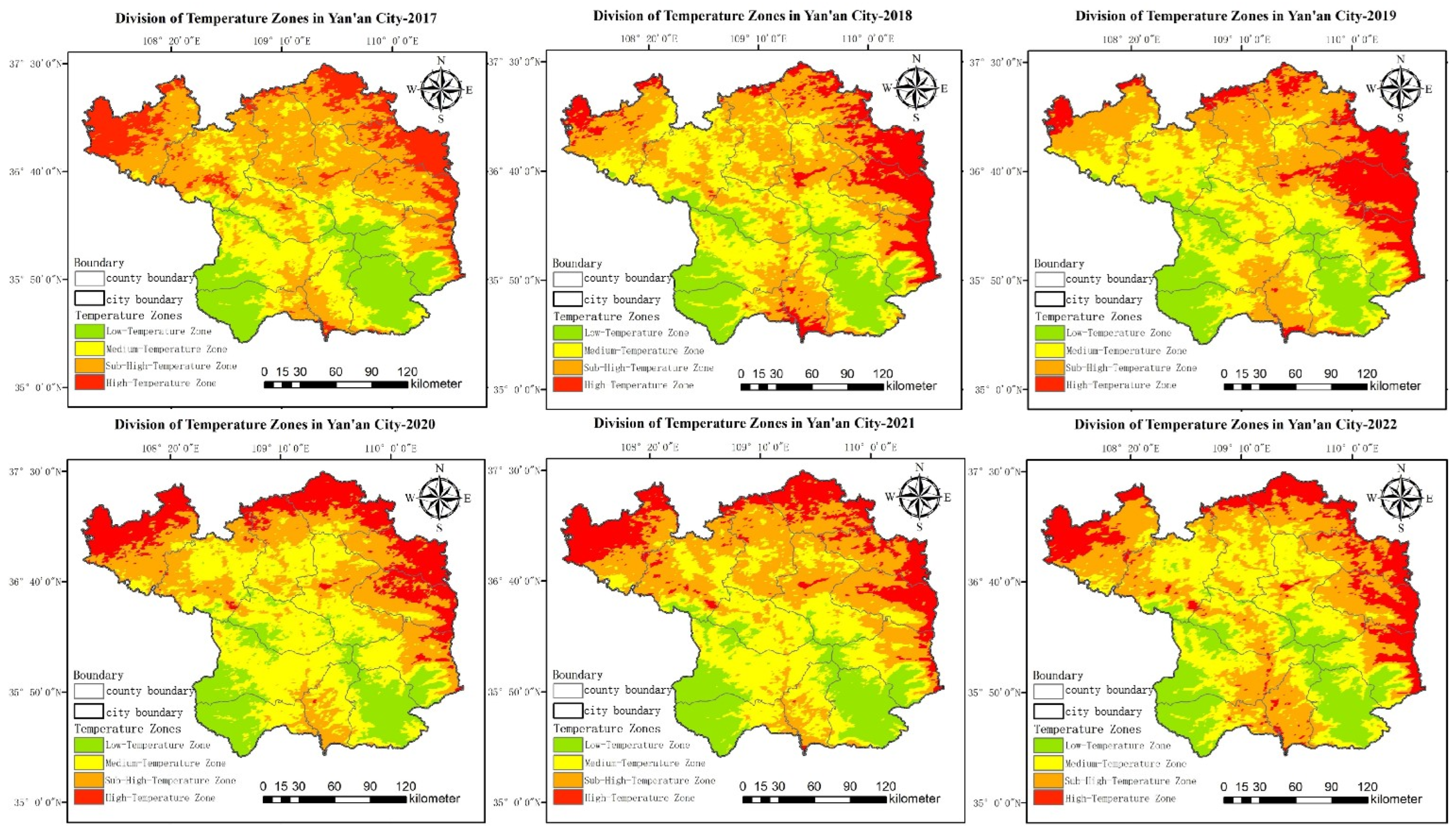
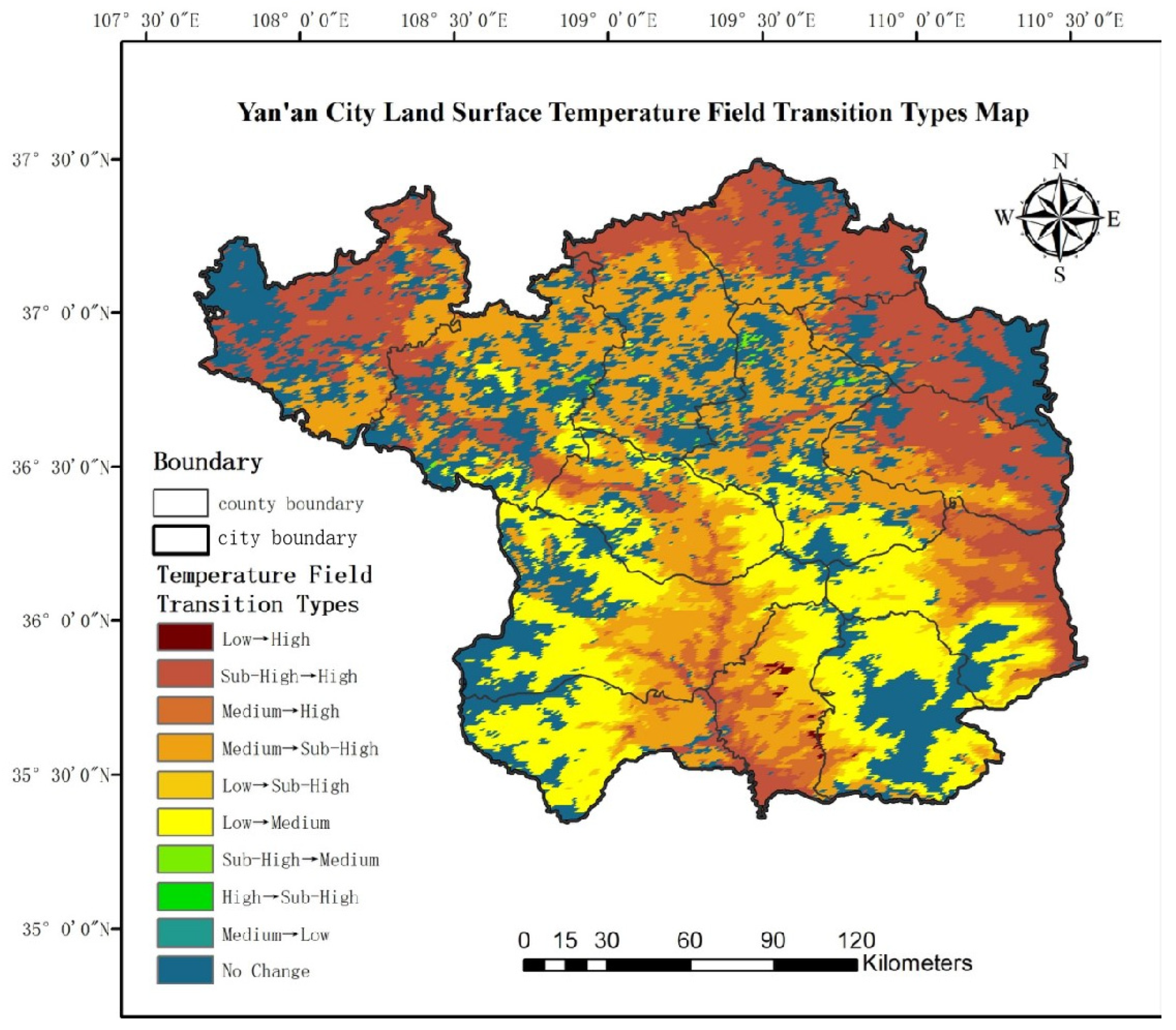
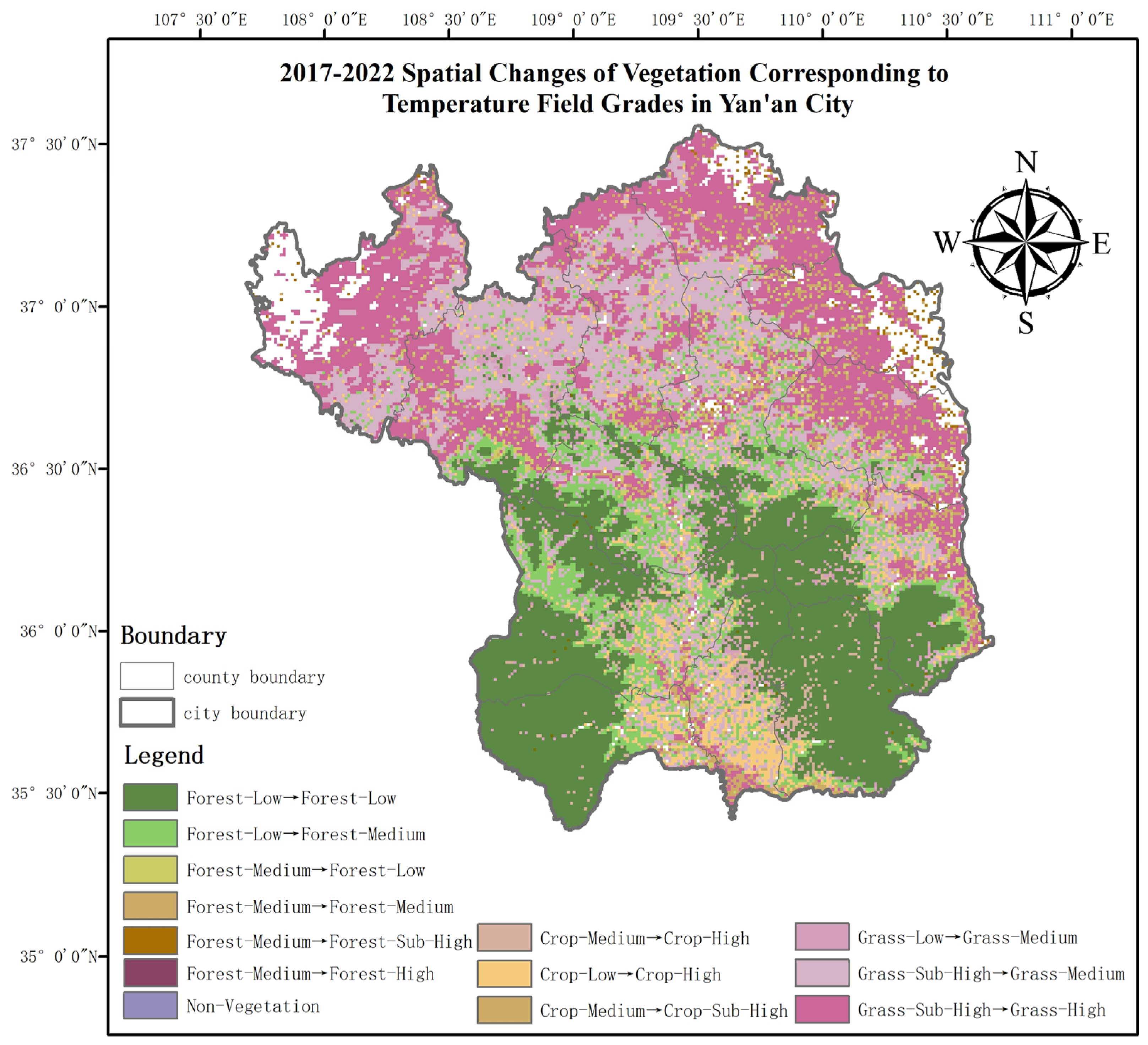

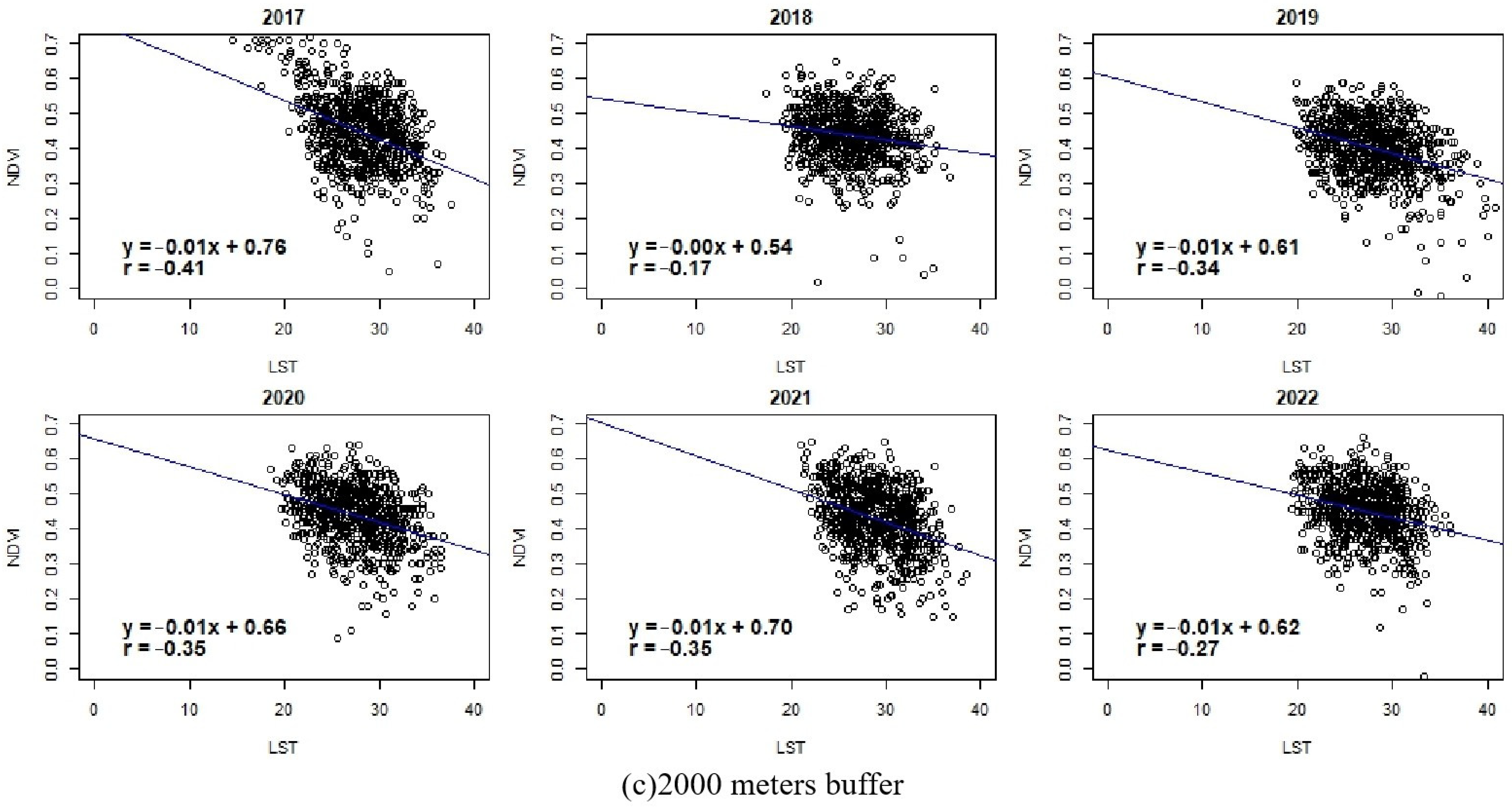
| MODIS Land Products | Date | Band | Resolution (M) |
|---|---|---|---|
| MYD11A1 | 2017-06-01 to 2017-08-31 | LST_Day_1km | 1000 |
| 2018-06-01 to 2018-08-31 | |||
| 2019-06-01 to 2019-08-31 | |||
| 2020-06-01 to 2020-08-31 | |||
| 2021-06-01 to 2021-08-31 | |||
| 2022-06-01 to 2022-08-31 | |||
| MYD13Q1 | 2017-06-02, 2017-06-18, 2017-07-04, 2017-07-20, 2017-08-05, 2017-08-21 | NDVI | 250 |
| 2018-06-02, 2018-06-18, 2018-07-04, 2018-07-20, 2018-08-05, 2018-08-21 | |||
| 2019-06-02, 2019-06-18, 2019-07-04, 2019-07-20, 2019-08-05, 2019-08-21 | |||
| 2020-06-01, 2020-06-17, 2020-07-03, 2020-07-19, 2020-08-04, 2020-08-20 | |||
| 2021-06-02, 2021-06-18, 2021-07-04, 2021-07-20, 2021-08-05, 2021-08-21 | |||
| 2022-06-02, 2022-06-18, 2022-07-04, 2022-07-20, 2022-08-05, 2022-08-21 |
| Temperature Field Level | Division Criteria | Colors |
|---|---|---|
| High-Temperature Zone | Ts > μ + std |  |
| Sub-High-Temperature Zone | μ < Ts ≤ μ + std |  |
| Medium-Temperature Zone | μ − std ≤ Ts B ≤ μ |  |
| Low-Temperature Zone | Ts < μ − std |  |
| Year | 2017 | 2018 | 2019 | 2020 | 2021 | 2022 |
|---|---|---|---|---|---|---|
| NDVI < 0.2 Area (km2) | 1406.97 | 1139.67 | 1063.11 | 1108.05 | 1030.19 | 1290.05 |
| 0.2 ≤ NDVI < 0.3 Area (km2) | 4797.89 | 4434.93 | 4224.29 | 2810.69 | 3433.87 | 3653.89 |
| 0.3 ≤ NDVI < 0.4 Area (km2) | 8838.54 | 9110.37 | 8189.67 | 5768.63 | 6430.16 | 6491.21 |
| 0.4 ≤ NDVI < 0.6 Area (km2) | 16,441.83 | 15,972.63 | 15,511.55 | 18,333.07 | 16,391.66 | 15,219.67 |
| NDVI > 0.6 Area (km2) | 5546.07 | 6373.70 | 8042.68 | 9310.08 | 9745.42 | 10,376.48 |
| Year | Vegetated Area (km2) | Proportions (%) | Non-Forested Area (km2) | Proportions (%) |
|---|---|---|---|---|
| 2017 | 31,274.56 | 84.45 | 5756.74 | 15.55 |
| 2018 | 29,711.38 | 80.23 | 7319.92 | 19.77 |
| 2019 | 31,115.27 | 84.02 | 5916.03 | 15.98 |
| 2020 | 31,890.30 | 86.12 | 5141.00 | 13.88 |
| 2021 | 33,863.04 | 91.44 | 3168.26 | 8.56 |
| 2022 | 34,638.03 | 93.54 | 2393.27 | 6.46 |
| Year | Mean | std | High- Temperature Zone | Sub-High- Temperature Zone | Medium- Temperature Zone | Low- Temperature Zone |
|---|---|---|---|---|---|---|
| 2017 | 32.82 | 3.04 | (35.86, +∞) | (32.82, 35.86] | (29.79, 32.82] | (−∞, 29.79) |
| 2018 | 30.41 | 2.51 | (32.92, +∞) | (30.41, 32.92] | (27.90, 30.41] | (−∞, 27.90) |
| 2019 | 32.01 | 3.29 | (35.30, +∞) | (32.01, 35.30] | (28.73, 32.01] | (−∞, 28.73) |
| 2020 | 31.58 | 3.24 | (34.81, +∞) | (31.58, 34.81] | (28.34, 31.58] | (−∞, 28.34) |
| 2021 | 32.96 | 3.45 | (36.41, +∞) | (32.96, 36.41] | (29.50, 32.96] | (−∞, 29.50) |
| 2022 | 31.27 | 2.46 | (33.73, +∞) | (31.27, 33.73] | (28.81, 31.27] | (−∞, 28.81) |
| Year | 2017 | 2018 | 2019 | 2020 | 2021 | 2022 |
|---|---|---|---|---|---|---|
| High-temperature zone area (km2) | 5742.94 | 6603.64 | 5534.25 | 5917.76 | 5534.25 | 6243.97 |
| Proportions (%) | 15.51 | 17.83 | 14.94 | 15.98 | 14.94 | 16.86 |
| Sub-high-temperature zone area (km2) | 15,071.38 | 10,894.97 | 13,677.28 | 12,698.32 | 13,677.28 | 12,916.84 |
| Proportions (%) | 40.70 | 29.42 | 36.93 | 34.29 | 36.93 | 34.88 |
| Medium-temperature zone area (km2) | 9195.81 | 13,505.35 | 11,379.24 | 11,839.37 | 11,379.24 | 11,199.22 |
| Proportions (%) | 24.83 | 36.47 | 30.73 | 31.97 | 30.73 | 30.24 |
| Low-temperature zone area (km2) | 7021.17 | 6027.34 | 6440.54 | 6575.86 | 6440.54 | 6671.27 |
| Proportions (%) | 18.96 | 16.28 | 17.39 | 17.76 | 17.39 | 18.02 |
| Average temperature in the UHI area (Tu/°C) | 37.10 | 34.35 | 37.31 | 36.6251 | 38.09 | 35.06 |
| Average temperature in other regions (Tr/°C) | 32.07 | 29.75 | 31.06 | 30.5261 | 31.97 | 30.59 |
| UHI intensity (SUHII/°C) | 5.03 | 4.60 | 6.26 | 6.10 | 6.12 | 4.48 |
| Year | Afforestation Area (km2) | Forest Type Purpose | |
|---|---|---|---|
| Economic Forest | Protective Forest | ||
| 2017 | 703.53 | 7.20 | 554.35 |
| 2018 | 689.72 | 13.46 | 384.27 |
| 2019 | 654.76 | 590.52 | |
| 2020 | 221.43 | 3.37 | 412.81 |
| 2021 | 775.77 | 729.71 | |
| 2022 | 1003.13 | ||
Disclaimer/Publisher’s Note: The statements, opinions and data contained in all publications are solely those of the individual author(s) and contributor(s) and not of MDPI and/or the editor(s). MDPI and/or the editor(s) disclaim responsibility for any injury to people or property resulting from any ideas, methods, instructions or products referred to in the content. |
© 2024 by the authors. Licensee MDPI, Basel, Switzerland. This article is an open access article distributed under the terms and conditions of the Creative Commons Attribution (CC BY) license (https://creativecommons.org/licenses/by/4.0/).
Share and Cite
Wang, X.; Chen, Y.; Wang, Z.; Xu, B.; Feng, Z. Multi-Temporal Analysis of the Impact of Summer Forest Dynamics on Urban Heat Island Effect in Yan’an City. Sustainability 2024, 16, 3473. https://doi.org/10.3390/su16083473
Wang X, Chen Y, Wang Z, Xu B, Feng Z. Multi-Temporal Analysis of the Impact of Summer Forest Dynamics on Urban Heat Island Effect in Yan’an City. Sustainability. 2024; 16(8):3473. https://doi.org/10.3390/su16083473
Chicago/Turabian StyleWang, Xinyi, Yuan Chen, Zhichao Wang, Bo Xu, and Zhongke Feng. 2024. "Multi-Temporal Analysis of the Impact of Summer Forest Dynamics on Urban Heat Island Effect in Yan’an City" Sustainability 16, no. 8: 3473. https://doi.org/10.3390/su16083473
APA StyleWang, X., Chen, Y., Wang, Z., Xu, B., & Feng, Z. (2024). Multi-Temporal Analysis of the Impact of Summer Forest Dynamics on Urban Heat Island Effect in Yan’an City. Sustainability, 16(8), 3473. https://doi.org/10.3390/su16083473








